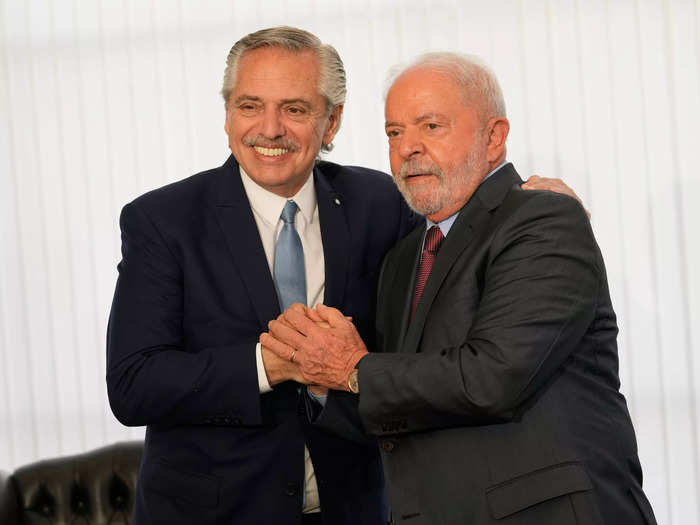
The dollar's dominance of global trade and reserves is facing several new threats.Getty Images
The dollar's dominance of global trade and investment flows is facing a slew of new threats as many countries push plans to boost the use of alternative currencies.
Nations from China and Russia to India and Brazil are pushing for settling more trade in non-dollar units – with plans ranging from the use of local currencies to a gold-backed stablecoin and a new BRICS reserve currency.
For decades, the greenback has reigned supreme as the world's reserve currency and is widely used in crossborder trade, especially for commodities such as oil. Thanks to its relative price stability, investors see it as a safe-haven asset in times of heightened economic and geopolitical uncertainty.
The dollar was further bolstered last year by a surge in US interest rates that made it attractive to foreign investors seeking higher yields. It surged 17% during the first nine months of 2022, but has since lost some of its shine on the prospect that the Federal Reserve may soon end its rate hikes as inflation cools rapidly.
Against this backdrop come the latest threats to the greenback's reign — here are five currency projects from across the world that are ultimately aimed at undermining the dollar's supremacy.

Brazil and Argentina recently announced they are gearing up to launch a joint currency, named the "sur" (south), that could eventually become a euro-like project embraced by all of South America.
A common currency could help boost South American trade, the countries' leaders said in a joint statement, because it evades conversion costs and exchange rate uncertainty. That could erode the dollar's dominance in the region, given the greenback accounted for as much as 96% of the trade between North and South Americas from 1999 to 2019, according to the Federal Reserve.

Russia and Iran are working together on a cryptocurrency backed by gold — a 'stablecoin' that could replace the dollar for payments in international trade.
The two countries, both of which have been hit by Western sanctions, want to issue a "token of the Persian region" for use in crossborder transactions, with a plan to launch it in a special economic enclave in Astrakhan in southern Russia, which already handles Iranian shipments.
But the project can move forward only once Russia's market for digital assets is fully regulated, according to a Moscow lawmaker.
Russia and Iran have stepped up their push to "de-dollarize" in recent months, according to think tank the Jamestown Foundation. They aim to increase their volume of trade to $10 billion per year via moves such as developing an alternative international payments system to SWIFT, which they are banned from.

Meanwhile, the United Arab Emirates and India have floated the idea of conducting non-oil trade in rupees.
The move would build on a free trade agreement signed last year, which aims to boost trade excluding oil between the two countries to $100 billion by 2027.
China has also pondered on the idea of settling non-oil trade in local currencies that exclude the greenback, according to minister of state for foreign trade of the UAE Thani bin Ahmed Al Zeyoudi.

China, for another, is looking to weaken the dollar by pushing for the yuan to replace the greenback in oil deals, given its increased trade with Russia after it invaded Ukraine.
The move looks to chip away at the petrodollar regime in place since the 1970s, where global oil transactions are largely settled in dollars.
Toward the end of last year, Beijing began buying Moscow's crude at steep discounts, completing those purchases in yuan rather than dollars, giving rise to the so-called petroyuan.
With a stronger greenback, oil contracts become more expensive because the deals are largely priced in the US currency, and this also explains China's shift away from the dollar.
Kpler analyst Viktor Katona said Russia has effectively become "an Asian nation that in my opinion has introduced the yuan into large-scale oil trade."

Last year, Russia and China kickstarted talks to develop a new reserve currency with other BRICS countries in a challenge to the dollar's dominance.
The new reserve unit would be based on a basket of currencies from the group's members: Brazil, Russia, India, China, and South Africa.
The dollar's reign as the chief reserve tender is already on the wane as central bankers diversify their holdings into currencies like the Chinese yuan, the Swedish krona and the South Korean won, according to the International Monetary Fund.
 Saudi Arabia wants China to help fund its struggling $500 billion Neom megaproject. Investors may not be too excited.
Saudi Arabia wants China to help fund its struggling $500 billion Neom megaproject. Investors may not be too excited. I spent $2,000 for 7 nights in a 179-square-foot room on one of the world's largest cruise ships. Take a look inside my cabin.
I spent $2,000 for 7 nights in a 179-square-foot room on one of the world's largest cruise ships. Take a look inside my cabin. One of the world's only 5-star airlines seems to be considering asking business-class passengers to bring their own cutlery
One of the world's only 5-star airlines seems to be considering asking business-class passengers to bring their own cutlery Experts warn of rising temperatures in Bengaluru as Phase 2 of Lok Sabha elections draws near
Experts warn of rising temperatures in Bengaluru as Phase 2 of Lok Sabha elections draws near
 Axis Bank posts net profit of ₹7,129 cr in March quarter
Axis Bank posts net profit of ₹7,129 cr in March quarter
 7 Best tourist places to visit in Rishikesh in 2024
7 Best tourist places to visit in Rishikesh in 2024

Copyright © 2024. Times Internet Limited. All rights reserved.For reprint rights. Times Syndication Service.